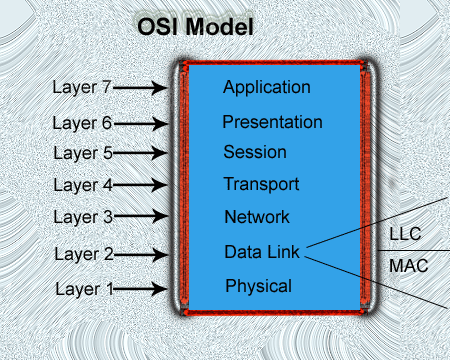Questions on OSI Model with answers-

OSI Reference Model
Q1- What does the acronym OSI stand for ?
Ans- Open System Interconnection. The OSI reference model is used as a guide for teaching and understanding the way networks operate.
Ans- Open System Interconnection. The OSI reference model is used as a guide for teaching and understanding the way networks operate.
Q2- What are the layers of the OSI model?
Ans- Application, Presentation, Session, Transport, Network, DataLink, Physical. An easy way to remember the order of the layers is: A-ll P-eople S-eem T-o N-eed D-ata P-rocessing .
Ans- Application, Presentation, Session, Transport, Network, DataLink, Physical. An easy way to remember the order of the layers is: A-ll P-eople S-eem T-o N-eed D-ata P-rocessing .
Q3- At which layer of the OSI model is a path decision made based upon an IP address ?
Ans- Network. At the network layer, data is transported in the form of a packet.
Ans- Network. At the network layer, data is transported in the form of a packet.
Q4- Which of the following takes place at the presentation layer ?
Ans- Encryption. The presentation layer encrypts data to be sent across the network, and decrypts it so that it can be accessed by the application layer on the receiving end.
Ans- Encryption. The presentation layer encrypts data to be sent across the network, and decrypts it so that it can be accessed by the application layer on the receiving end.
Q5- Which is NOT a function of the Application layer ?
Ans- Windowing. Quality of Service and user authentication are also handled by the application layer.
Ans- Windowing. Quality of Service and user authentication are also handled by the application layer.
Q6- Which layer of the OSI model contains the LLC sublayer and the MAC sublayer ?
Ans- Data Link Layer. The LLC and MAC sublayers allow for different layer 2 protocols to be used, such as Ethernet, Token Ring and FDDI.
Ans- Data Link Layer. The LLC and MAC sublayers allow for different layer 2 protocols to be used, such as Ethernet, Token Ring and FDDI.
Q7- How can data be transported in different layers ?
Ans- Data is transported in bits at the Physical layer . A bit is simply a binary digit. Either a 0 or a 1 . Data is transported in segments at the Data Link layer . At the data link layer, user data is encapsulated in a frame.
Ans- Data is transported in bits at the Physical layer . A bit is simply a binary digit. Either a 0 or a 1 . Data is transported in segments at the Data Link layer . At the data link layer, user data is encapsulated in a frame.
Q8- What is the function of Network Layer ?
Ans- The network layer establishes the route between the sender and receiver across switching points, which are typically routers. The most ubiquitous example of this layer is the IP protocol in TCP/IP. IPX, SNA and AppleTalk are other examples of routable protocols, which means that they include a network address and a station address in their addressing system. This layer is also the switching function of the dial-up telephone system. If all stations are contained within a single network segment, then the routing capability in this layer is not required.
Ans- The network layer establishes the route between the sender and receiver across switching points, which are typically routers. The most ubiquitous example of this layer is the IP protocol in TCP/IP. IPX, SNA and AppleTalk are other examples of routable protocols, which means that they include a network address and a station address in their addressing system. This layer is also the switching function of the dial-up telephone system. If all stations are contained within a single network segment, then the routing capability in this layer is not required.
Q9- The link for a switch connection is isolated from other data traffic except for what type of messages?
Ans- Following are the types of messages-
i. Multicast Messages – Message are sent to a specific group of hosts on the network.
ii. Broadcast Messages – Message is sent to all devices connected to the LAN.
Ans- Following are the types of messages-
i. Multicast Messages – Message are sent to a specific group of hosts on the network.
ii. Broadcast Messages – Message is sent to all devices connected to the LAN.
Q10- Why are the layers of the OSI model important to the network administrator?
Ans- The Layers of OSI Model are important for the network administrator in the following manner-
i. To troubleshoot network problems by verifying functionality of each layer.
ii. In many cases it requires the network administrator to isolate at what layer the network problem occurs.
Ans- The Layers of OSI Model are important for the network administrator in the following manner-
i. To troubleshoot network problems by verifying functionality of each layer.
ii. In many cases it requires the network administrator to isolate at what layer the network problem occurs.

.png)
No comments:
Post a Comment
*******Please Comment, Like and Share******
दोस्तों पूरी पोस्ट पढने के लिए धन्यवाद, आशा करता हूँ आप को यह पोस्ट पसंद आई होगी और भी अधिक जानकारी के लिए या मुझसे जुड़ने के लिए आप मुझे मेरे फेसबुक पेज information & technology computer institutions और इन्स्टाग्राम ID:- satyam_hardoi को फॉलो कर सकते है,
मेरा youtube चैनल itci computer hardoi सर्च करे और पाए कंप्यूटर से सम्बंधित सभी विडियो और हाँ प्लीज नई अपडेट पाने के लिए चैनल को सब्सक्राइब जरुर करें, धन्यवाद | आपका $ सत्यम सर् $